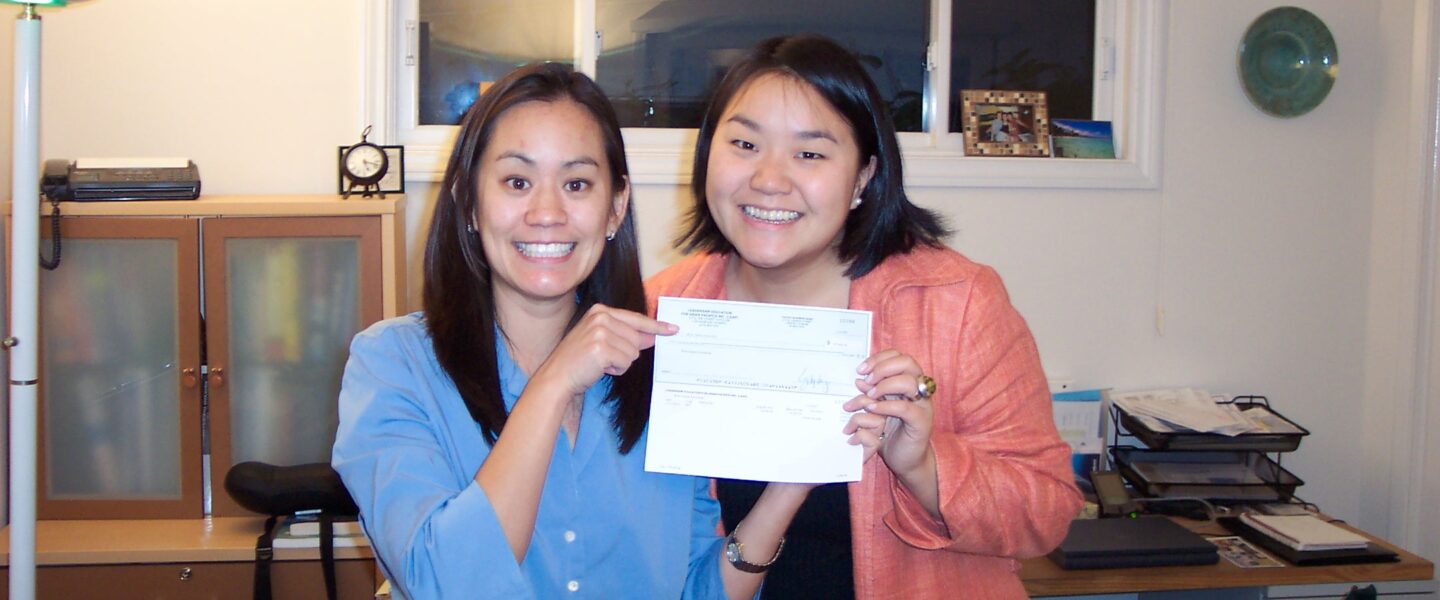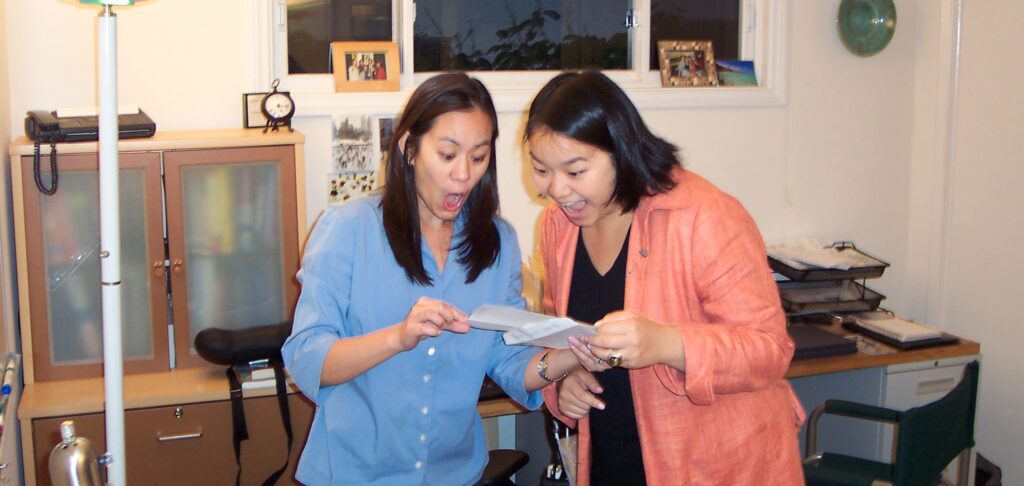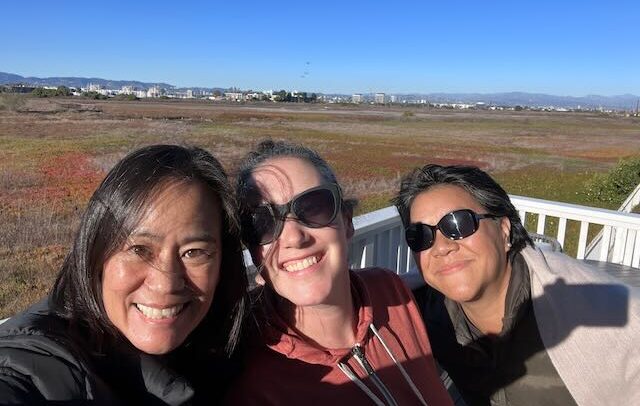
Jenni and Way-Ting hold up their first client check!
Interview with Founding Partners—Way-Ting and Jenni— and Sarah Eguchi Low
In the Blue Garnet office, I sat down with our Founding Partners, Way-Ting Chen and Jennifer Shen. Together we take a walk down memory lane to hear about the founding and early days of Blue Garnet. Enjoy learning about how these college best friends became “accidental entrepreneurs” in the pursuit of solving social problems while forging a path towards sustainability and balance.
Sarah Eguchi Low (hereafter, “S”): What inspired you to start Blue Garnet?
Way-Ting (“WT”): Jenni and I became best friends at Swarthmore college, then lived together after college in New York City. Jenni worked at TCC Group, a consulting firm that worked in the social sector, and I didn’t fully understand what you did. It wasn’t until later, when I was in management consulting and worked with Reverend Dr. Joan S. Parrott on a pro bono project with the Children’s Defense Fund (CDF) that I really understood what Jenni did!
Jenni (“J”): After living together in New York City, we went off to our graduate programs and then both ended up in management consulting in the private sector— Way-Ting at Booz Allen in New York, and me at Boston Consulting Group (BCG) in LA. During Labor Day weekend 2002, l happened to be in NYC and reached out to Way-Ting. She invited me to see her client at CDF, Reverend Parrott, preach at the historic Riverside Church in Morningside Heights on Sunday.
WT: Reverend Parrott worked at CDF and preached at various churches on the weekend. She had an aura of calm, serenity, and strength. She was confident and not afraid to challenge you. So that Sunday, we attended the service where she was preaching, and at the end she challenged us to take action.
J: She was preaching from the Old Testament, about this place called Lo Debar, a place of desolation and isolation where people avoid. And she made an analogy to our modern-day context, challenging us, “Where’s the place that you don’t want to go to go?” At the time, I was really thinking about making a change. I’d been at BCG for two years and was thinking about what’s next, especially after 9/11. So Reverend Parrott’s call really resonated.
As Way-Ting and I sipped coffee after the service, I blurted out, asking out of the blue, “What if we did something together, Way-Ting?” I remember thinking, “What do we care about – social justice issues! What are we good at? Consulting, problem solving? Can we do that?” Way-Ting seemed intrigued. Two days later, Way-Ting called me.
WT: I called Jenni and said, “Are you serious? What if we actually do something?” That then sparked a more serious conversation over what we could do and what made sense. That was Labor Day 2002. On Halloween, I left New York City and flew out to LA. I was ready. I’d been at Booz Allen for three years, had spent the last year in the fallout of 9/11, and had some epiphanies about what kind of a person I really wanted to be. And so I knew this was a move that I needed to make.
J: A month later, you moved into the guest room in our house, which had plenty of space because I had just gotten married and moved in. Our extra room became our first Blue Garnet office. It seems crazy now, but at the time it just made sense. It didn’t feel crazy or actually that hard.

Jenni and Way-Ting holding up their first client check in said “office”
S: Did you meet resistance along the way? People doubting that it could work? Moments that you thought you might have to close the doors?
WT: I had some people, like my family, who asked, “Are you sure? How well do you know Jenni?” We got a lot of questions around starting a business with a friend. Because we had gone to school together, lived together…
J: …Had arguments together and resolved them.
WT: It was a lot of ups and downs. But because of that, starting a business with a friend didn’t feel as risky as it might sound.
J: Well, we did have counsel from some folks who said, your friendship will change. So early on, we had to understand that our friendship needed to be prioritized, and that it would change. And over the years we’ve had to tell one another that I’m going to take off my “business partner hat” and put on my “friend hat.”
WT: It’s been over 20 years now, and we’ve grown individually, too. So the friendship changes in part because we change. But I think the secret sauce is us having this foundation of trust with each other. And that allowed us to take the leap and go!
S: It sounds like you were both at this inflection point. The timing was perfect!
J: It really was. There were basically three things for me, which resonated with Way-Ting also. One, a hunger to get back to the work of social change. Second, wanting to use experience in consulting. Third, that Way-Ting and I were willing to do this together. So we became accidental entrepreneurs! It’s a Venn diagram. What are we good at? What do we enjoy? What helps others or makes the world a better place? AND can we get paid at it? All these combined led to the idea of the grand experiment of Blue Garnet.
WT: And I would add that the world was at an inflection point. Bridgespan and other social impact consulting firms did not exist back then. Today, there are many places that blend business acumen with social impact— for profit AND social impact. But twenty years ago, there were more of these ORs— nonprofit OR corporate, for profit OR social impact. We didn’t see any ANDs, so we had to create it. Hence, accidental entrepreneurs!
S: Tell me more about this new path you were forging, what other decisions were you making as you built out the identity of Blue Garnet as a firm?
WT: We were hustling to build the business and the client base, but also adapting the things that we learned at our respective for-profit management consulting firms. We realized that we had to make intentional decisions to make Blue Garnet work more sustainably and to think of ourselves as whole people.
J: We had to figure out, what is the Blue Garnet way? We knew it was going to be different.
WT: Because the work of social change is different! The issues of social change are so complex, there’s not actually one right answer. We really had to figure out how to build an approach to strategy formation and problem-solving that made careful use of research and analytics to get what you need while bringing groups of people along in the decision-making process.
J: And now we say it all the time: You have to involve the right people, in the right way, at the right time through the process. This was one of our early learnings.
S: I’d love to hear about some of your early projects. What were they like?
J: Our first projects were with people I had met early in my career. Our first client was JD Hokoyama at LEAP (Leadership Education for Asian Pacifics) who wanted help making the case for LEAP’s hybrid nonprofit and earned income model…their unique value proposition as a national leadership development and education organization. So it was a perfect opportunity combining our passion for social change and business acumen!
Also, one of my first bosses, Antonio Manning, gave me the opportunity to participate in Los Angeles Urban Funders (LAUF)— a network of funders coming together after the Los Angeles civil unrest following the arrest and beating of Rodney King. So, I was just this young punk showing up at meetings with these amazing philanthropic leaders. Many became mentors and our first clients.
WT: Another early clients was Elwood Hopkins and Daniel Tellalian at Emerging Markets—a thrilling project! It was a classic market research consulting project. But the goal was not ‘maximizing profit;” rather, it was to understand and help address historic redlining by financial institutions. The Emerging Markets team wanted to help create better banking in LA’s vulnerable neighborhoods.
J: It was right time, right place. The market of social change was ready. Another early project was with CDTech, with Denise Fairchild, to understand the “digital divide” experienced by unhoused people.
As I reflect on these early projects, I see we were very flexible and entrepreneurial. We took on many different roles, and people were kind and generous. Our clients were big supporters of us and wanted to see us succeed. We’re so grateful!
WT: We were very fortunate to have the right help along the way.
S: That’s great that you had the opportunity to work with such amazing leaders who really were champions of Blue Garnet. Any reflections of starting BG as young, women entrepreneurs?
J: Yes, not everything was peachy keen. Sometimes it was tough being a female leader in spaces that have historically been a “man’s world” and we don’t fit. We were young, female, and Asian. Sometimes we wondered if we hit the “bamboo ceiling,” too.
WT: Yet the world has changed a lot since we started the firm. One of the most distinct changes is how people talk about differences. The conversations now around representation, sexism, racism, ageism, other-isms tend to be framed with an asset-based view and are more explicit and direct. But not back then. We had to create our way and still “fit” in the dominant culture. We’re thankful to now be able to celebrate some of these differences as a strength to leverage, as opposed to a weakness to contain.
S: What about challenges as working moms? Other challenges?
WT: From the start, we knew we had to be counter-cultural in how we built a firm. For instance, we knew we were creating something beyond just the two of us. We didn’t name the firm after ourselves. Also, we sought a balance and wanted to bring our whole selves to work. We knew that working 60-80 hours a week did not leave enough time or energy to play our other roles and live well (friend, daughter, wife, and eventually mother). This aspect of our grand experiment– balancing being moms and running a firm, has been an ongoing challenge.
J: Figuring this piece out has been an ongoing, strategic, and dynamic tension.
WT: And figuring it out as a team has been impactful! Demonstrating you really can run a social business while keeping a healthy life and family.
J: Another challenge was navigating sustainability in the face of unknowns. But as we grew confidence in our business and services, the unknown became less scary. During the Great Recession, we were pressed and had to take out a small business loan. But we realized that Blue Garnet offered something valueable and was worth investing in.
S: That’s amazing! Anything else to share?
J: I just want to say to Way-Ting, “Thanks for being my partner.” It’s like a work marriage. We’ve been through a lot together and have known each other for over thirty years! Having just come back from my Sabbatical, it makes me really grateful for our partnership.
And then to add to that is Shannon, of course. As our first new Partner, she has shown great resilience, adaptability, and grace. She is a core part of who we are now!
WT: True! She’s been without us now for more than half of BG. And thank you, too, Jenni. I would not have done this without you. The world has changed so much since we started, and we have grown as people, too. Looking back helps us be thankful for how far we have come!

At our favorite spot in Playa Del Rey, CA, “retreating” as a Partner team, December 2023
Thanks for joining us on this journey! If you have more questions about Blue Garnet or our work, please reach out to hello@bluegarnet.net
